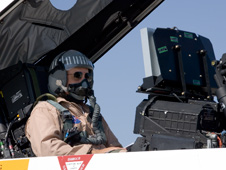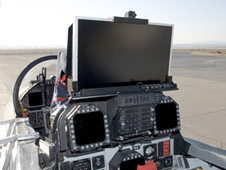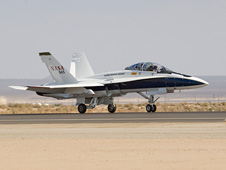- NASA Home
- | News & Features
- | News Topics
- | Aeronautics
- | Features
Feature
Text Size
NASA and Gulfstream Flying in High Def
10.27.08
 Gulfstream pilot Tom Horne readies to fly an XVS flight from the backseat of NASA's F-18 SRA. NASA photo/Tony Landis
NASA is partnering with Gulfstream Aerospace Corp. on a project that could aid visibility for pilots of future supersonic business jets.
Gulfstream pilot Tom Horne readies to fly an XVS flight from the backseat of NASA's F-18 SRA. NASA photo/Tony Landis
NASA is partnering with Gulfstream Aerospace Corp. on a project that could aid visibility for pilots of future supersonic business jets.
The External Vision System, or XVS, project is demonstrating the use of a high definition video camera and monitor system on the F-18B Systems Research Aircraft at NASA's Dryden Flight Research Center to identify human factor aspects associated with reduced visibility from the cockpit.
Some new low sonic boom supersonic business jet designs now on the drawing board compromise forward visibility because they have longer, streamlined noses that blend into the fuselage, eliminating the usual raised cockpit windows. The new high-definition, or HD, camera system is being tested to determine its effectiveness in replacing the normal forward visibility available in such aircraft. Minimum display resolution requirements for safe flight and ground operations are being investigated using various camera and display resolution configurations.
 The XVS project's HD display mounted on the rear instrument panel of NASA's F-18 SRA. NASA photo/Tony Landis
The XVS project's HD display mounted on the rear instrument panel of NASA's F-18 SRA. NASA photo/Tony Landis"NASA and Gulfstream team worked hard to pull this project together, and now we're reaping the benefits by gathering the data we need," said Larry Myers, Dryden's External Vision System project manager.
Flight tests began in late September. During the flights, a NASA pilot occupies the front seat as the safety pilot, while a Gulfstream pilot flies the aircraft from the back seat using the HD video system.
An HD camera is mounted behind the head-up display in the F-18's front cockpit, with an HD display mounted in the rear cockpit. The time-stamped HD video is recorded onboard and simultaneously transmitted to a control room at NASA Dryden.
 NASA research pilot Jim Smolka prepares to take off in NASA's F-18 SRA for an External Vision System project flight. NASA photo/Tony Landis
The F-18's rear cockpit canopy is modified with an interior cover cut to simulate windows that are sized and positioned to investigate peripheral cues required by normal piloting tasks using XVS. Size and placement will be modified based on pilot performance and evaluations.
NASA research pilot Jim Smolka prepares to take off in NASA's F-18 SRA for an External Vision System project flight. NASA photo/Tony Landis
The F-18's rear cockpit canopy is modified with an interior cover cut to simulate windows that are sized and positioned to investigate peripheral cues required by normal piloting tasks using XVS. Size and placement will be modified based on pilot performance and evaluations.
A second Dryden F-18 mission support aircraft sometimes flies as a target aircraft to help determine the video system's acuity in spotting other aircraft in flight.
The effort is a collaboration between Gulfstream and the Supersonics Project within the NASA Aeronautics Research Mission Directorate's Fundamental Aeronautics Program in Washington, D.C. NASA's participation is focused on performing fundamental research, development, test and evaluation of flight deck and related technologies to support supersonic aircraft designs that would have greatly reduced sonic booms.
External Vision System photos are available online at: http://www.dfrc.nasa.gov/Gallery/Photo/F-18SRA/Small/index.html
Gray Creech
NASA Dryden Flight Research Center